Key CMS Features
- Intuitive Dashboard
- Responsive Themes
- Powerful Content Editing and Publishing Tools
- Version Control and Backups
- Multi-language Content Creation
- Publishing Controls
- Built-in SEO Tools
- Robust Integrations
- Detailed Analytics
- Pre-Made Templates
- Content Staging
- Security
- Support
- Migration
- AI-Powered Content Creation
- AI-Powered SEO Recommendations
1. Intuitive Dashboard
My admin dashboard is the heart and soul of my CMS experience. This hub allows me to manage all content production and distribution tasks right from one easy spot. The simplicity of my dashboard saves me time. I don’t need to click between pages to find a specific feature. I already know where everything is.
Take Content Hub, for example. In my dashboard, I can create multimedia blog posts and landing pages. I can also manage, optimize, and track the performance of my content. Since Content Hub is integrated with HubSpot’s marketing, sales, and service tools, I can analyze website traffic reports where I run A/B tests, manage ads, and edit URL redirects.
Pro tip: Think of the actions that you do most frequently on your site — like scheduling content, monitoring threats, and tracking user activity. Then make sure it’s available in your dashboard.
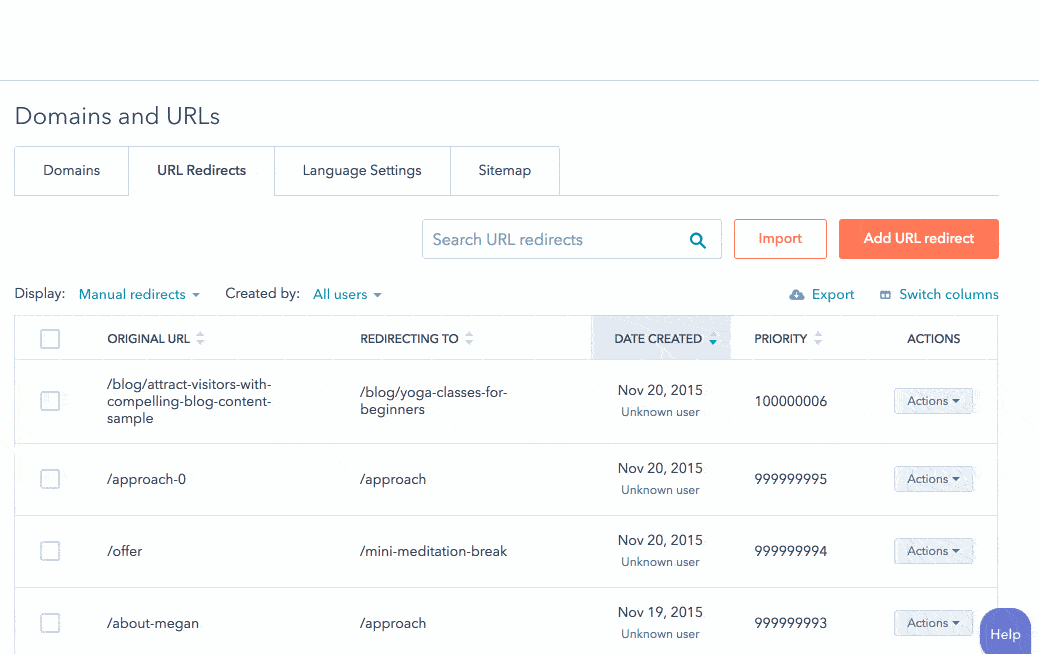
2. Responsive Themes
Themes allow you to create a consistent look and feel across your site. I am particular about this feature because, despite my limited website development experience, I still want my website to look good. Ideally, your CMS will offer a theme that you already like.
Themes have different use cases. A theme that works for a news site might not work for a personal website. For example, if you run an e-commerce site, you might want a theme that includes:
- Dropdown navigation support.
- A sticky sidebar area.
- Customizable content sections.
- A grid layout.
Depending on your CMS, you can download or purchase a theme that meets your requirements. For example, if you built your store using Shopify, then you could buy the Kingdom theme from Shopify’s official marketplace, shown here:
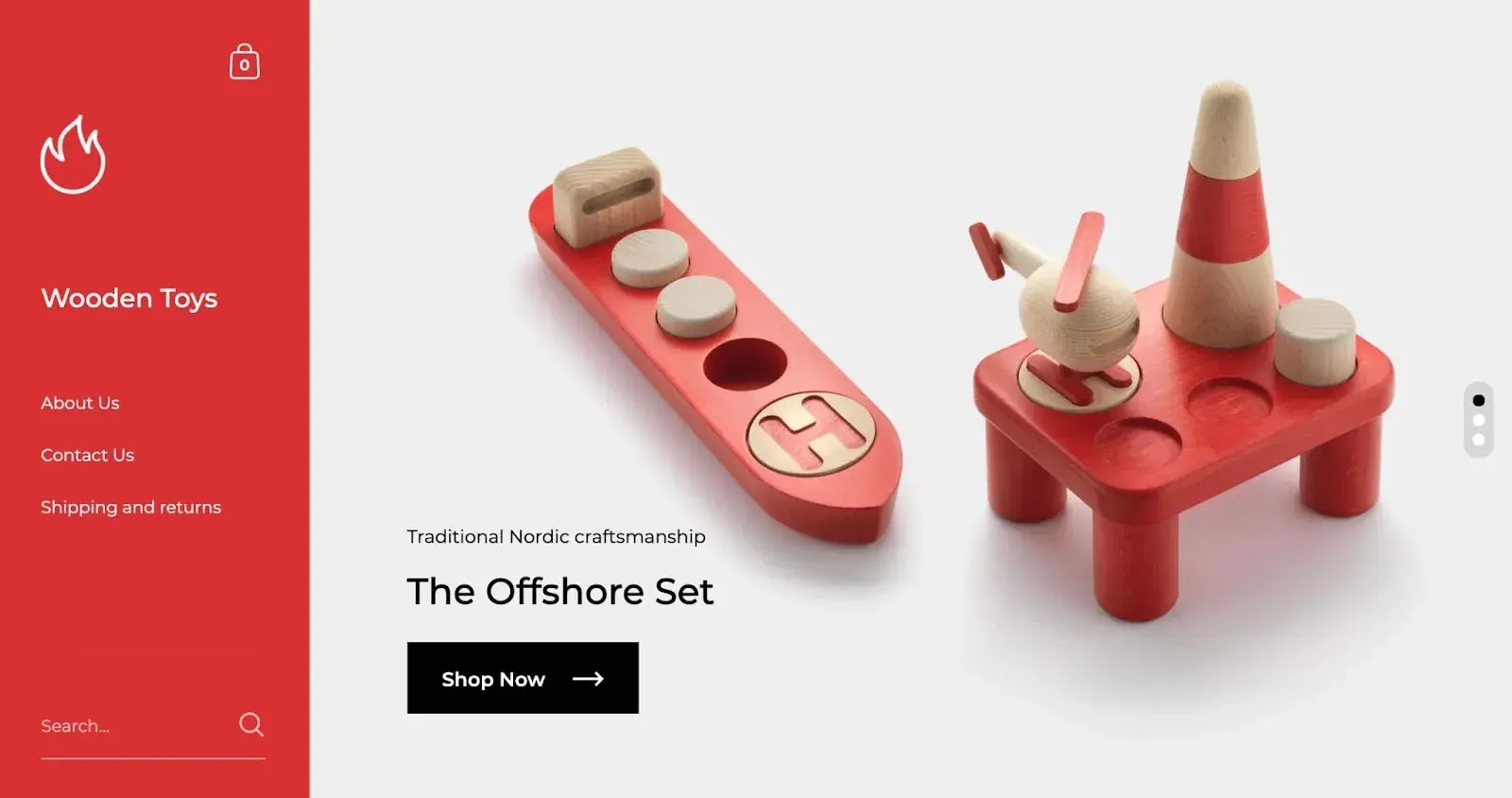
Beyond that, users will visit your site across devices. You need to make sure that the CMS offers responsive themes. This lets you optimize every post and page published on your site for all devices.
3. Powerful Content Editing and Publishing Tools
The less work you have to do to add content to your website, the more work you can put into making that content high-quality. So, you need a powerful content editor that allows you to easily create and publish different types of content. I’m talking about blog posts with custom layouts, landing pages with embedded resources, and pages with multimedia content.
I look for a CMS that lets me add images, videos, CTAs, forms, and more to any page that I want. I then look for an easy drag-and-drop interface that lets me rearrange these elements within the publishing interface. Lastly, I want to access a preview of the page before publishing.
Many CMS platforms have a WYSIWYG (“what you see is what you get”) editor that allows you to modify a page without writing HTML code and to see changes as you make them. Take a look at Webflow’s WYSIWYG editor below.

In addition to content editing features, I appreciate when a CMS makes it easy to schedule, publish, update, and otherwise manage content as needed. The publishing interface should be intuitive. I never want to accidentally publish unfinished content. The CMS should make that pitfall easy to avoid.
What if you have published pages you no longer need? Feature like the page expiration feature in Content Hub comes in handy.
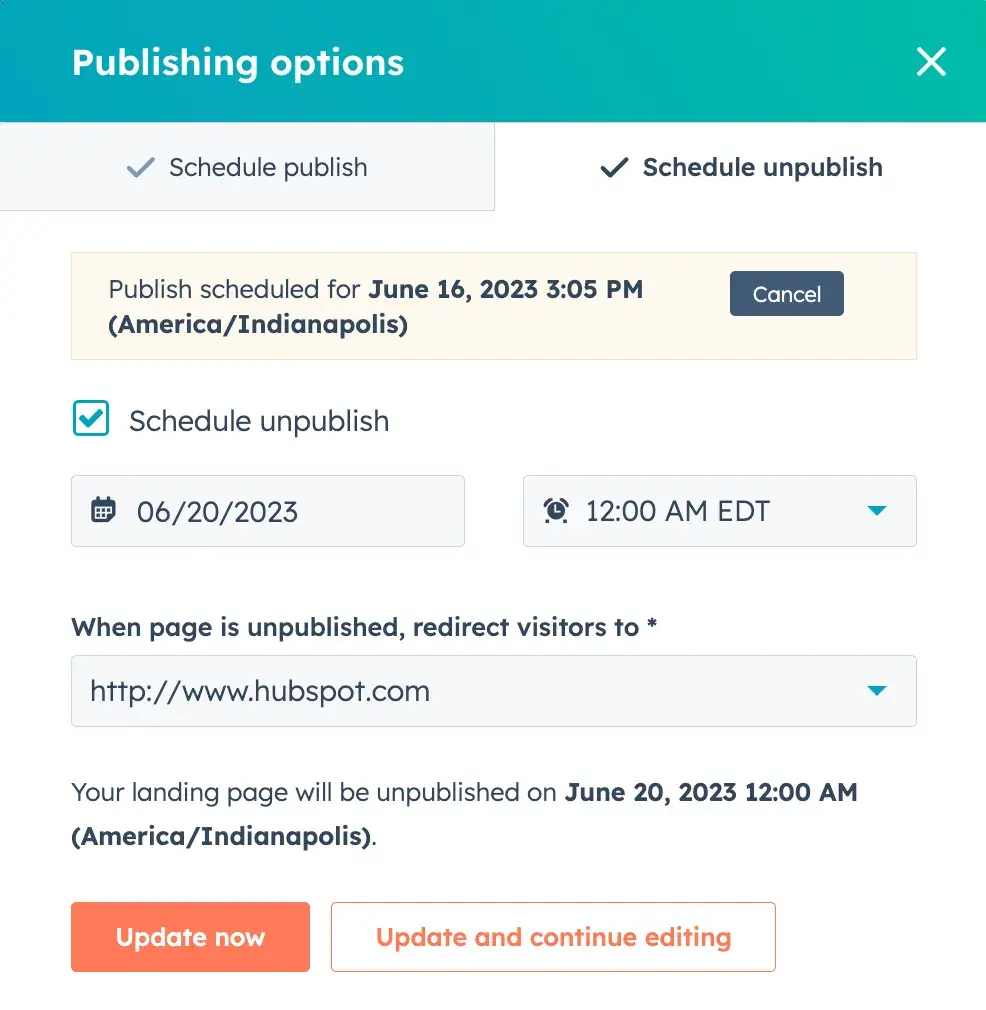
I use this feature for limited-time deals and event registration pages. I can use this feature to set a custom date and time when a page will expire, complete with a redirect.
4. Version Control and Backups
In addition to editing and publishing features, consider content management systems that allow you to save and track your work as you go. I prefer when my CMS autosaves my work instead of hitting “CMD + S” every five minutes.

Sometimes, you may need to revert to an old version of your content. Perhaps a large chunk of text was accidentally deleted during an update. We’ve all been there. Your CMS will ideally save different versions of your post, so you can access a previous version of a post when need be.
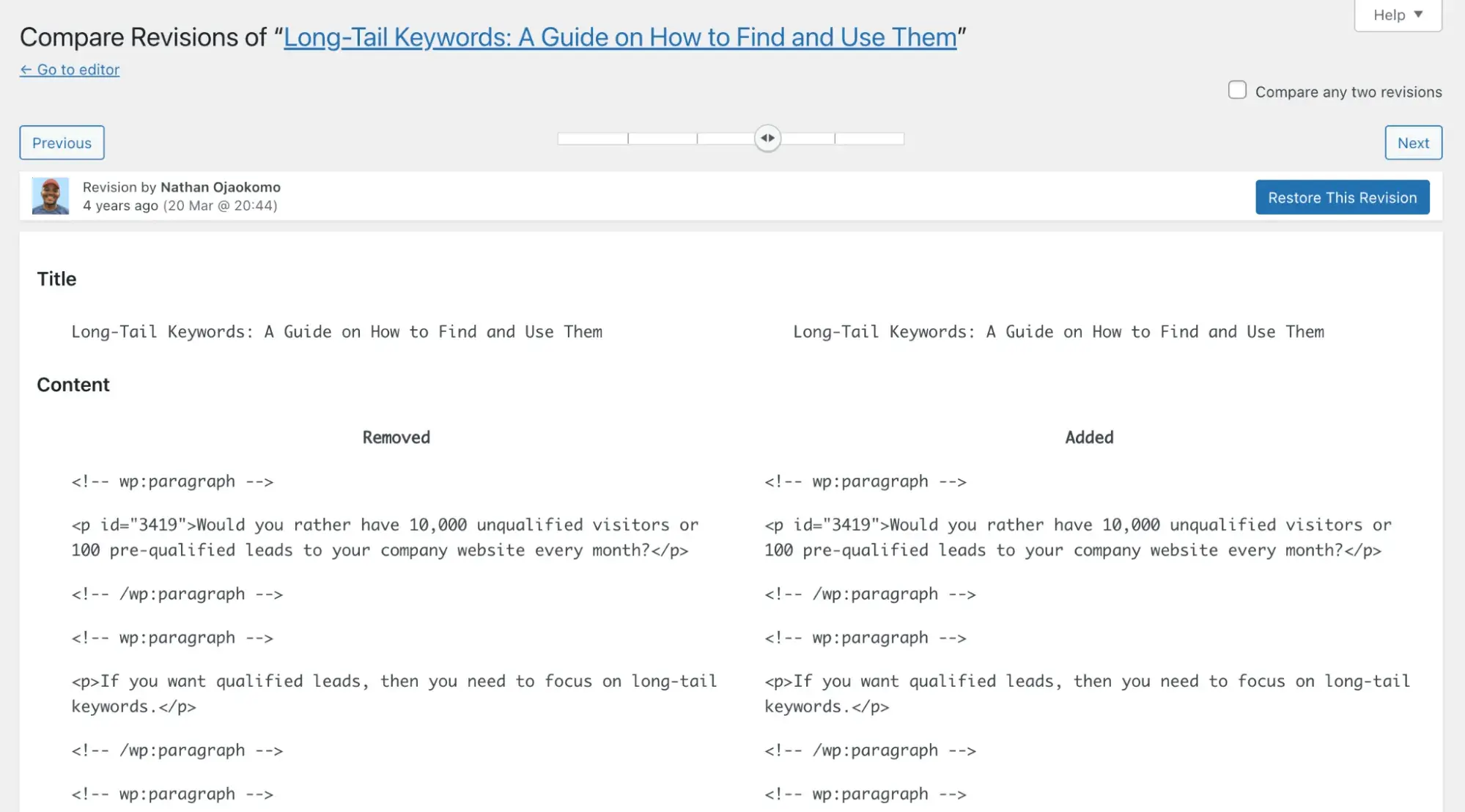
How does the CMS handle backups? Are they automatic, or do you need to create them manually? Are backups a native feature, or do you have to install an extension for them? It's best to find this out when you’re shopping around.
My current CMS uses a plugin to manage my backup, which I’ve found really helpful. I can choose my backup schedule, what I want included, and where to save the backup.
Note that your web host may also provide backup services for your site. Review your hosting plan (if you have one) to see if these services are included.
5. Multi-language Content Creation
This CMS feature should be a top consideration if you serve markets that speak different languages. A CMS with multi-language content features makes creating different versions of your pages quick and easy.
With Content Hub, you can create multi-language variants of a specific page and test them too. These variants are automatically associated in groups so you can continue to manage your multi-language content as you scale.
You can then add a language switcher module to your page template, allowing visitors to switch between translated versions of pages within the same multi-language group.

6. Publishing Controls
For my personal site, I’m the only person in charge of publishing on my website (after all, it’s a project with a team of one). However, if you work with a business, you’ll have multiple people with different permissions accessing your back end.
Some team members may be able to publish posts, others edit content, and others access design elements. You might have authors responsible solely for creating drafts, editors for reviewing those drafts, and administrators for scheduling and publishing them.
That’s why publishing controls are important in any CMS. Assigning different roles and levels of access helps you establish a workflow for creating, approving, and releasing different creative assets.
These publishing controls also prevent users from performing actions on your site that they shouldn’t be. You probably wouldn’t want a first-time freelance writer publishing their own post without your approval.
In WordPress, you can assign users one of five roles: Administrator, Editor, Author, Contributor, and Subscriber.
Each role has a different set of capabilities. Contributors, for example, can only create posts, not publish them. While authors can publish and manage their own posts, editors can publish and manage others’ posts.
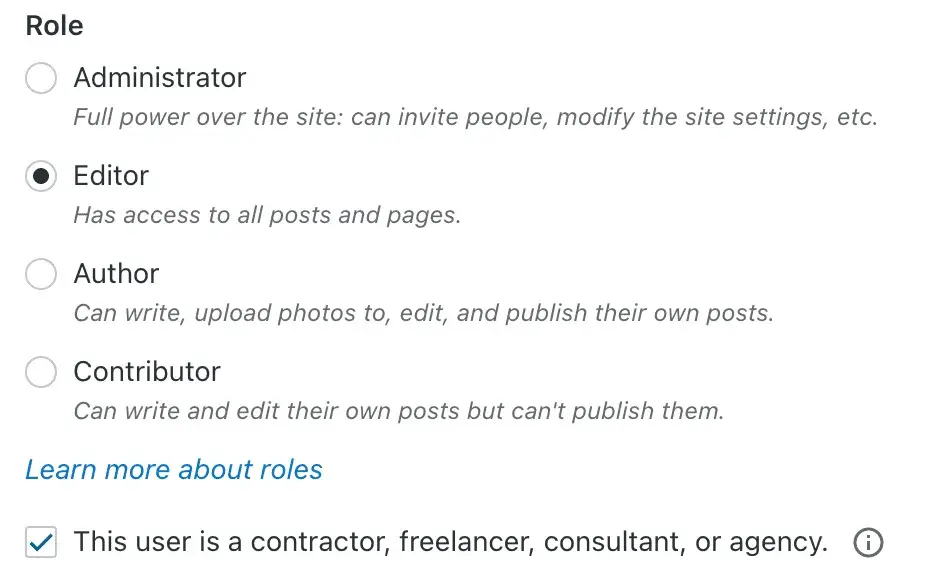
7. Built-in SEO Tools
Your work doesn’t matter if no one sees it. That’s why your website needs to be optimized for search engines. Some businesses have whole teams dedicated to SEO, but if you’re a small operation, it’s ideal to have these features built into your CMS.
Before choosing a CMS, ask questions like:
- Can I edit my URLs?
- Does it make my site load fast?
- Does it use proper HTML markup? SEO-friendly permalinks? Responsive design elements?
All your pages should follow these fundamental practices to be in good standing with search engines.
After that, see if the CMS offers any advanced SEO features. Content Hub offers SEO recommendations as you create content. The image below shows Content Hub’s SEO recommendations to include the keyword phrase in the title, add a meta description, and use two subtopics.
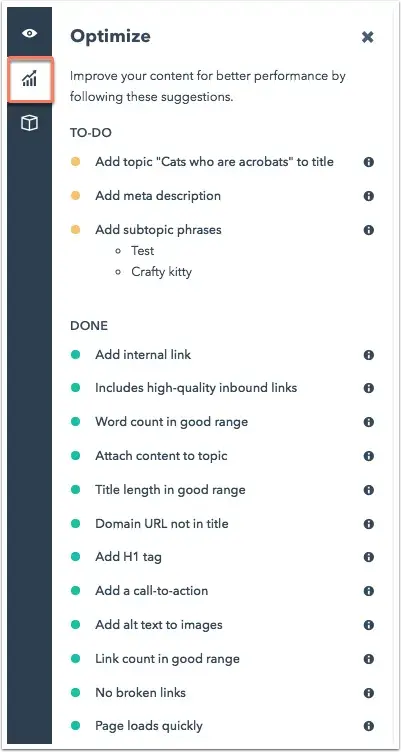
These suggestions help visitors and search engines better understand the page's content, thus improving your ability to rank.
8. Robust Integrations
I dream of a CMS that has every function I want. But, we live in reality, and no single CMS has all of these features out of the box. That’s where plugins come in. When I choose a CMS, I look out for how well it integrates with third-party software.
Here are some integrations you’ll want to check for when shopping for a CMS:
- Social media. A CMS should have integrated social capabilities to drive referral traffic to your site. Does it let you publish posts on social media? Can you add social media sharing buttons to your posts? Are social media analytics included in your dashboard?
- Marketing automation. Some content management systems might have built-in marketing automation features, but you might prefer to integrate with a third-party automation tool to drive more conversions.
- CRM. A CRM integration helps capture leads and organize them into a manageable system. For instance, you can connect WordPress with HubSpot via HubSpot’s WordPress Plugin.

While WordPress has one of the largest selections of extensions, with over 58,000 free plugins available in its directory, WordPress alternatives also offer impressive selections. Drupal, for example, has over 52,000 highly configurable modules in its directory.
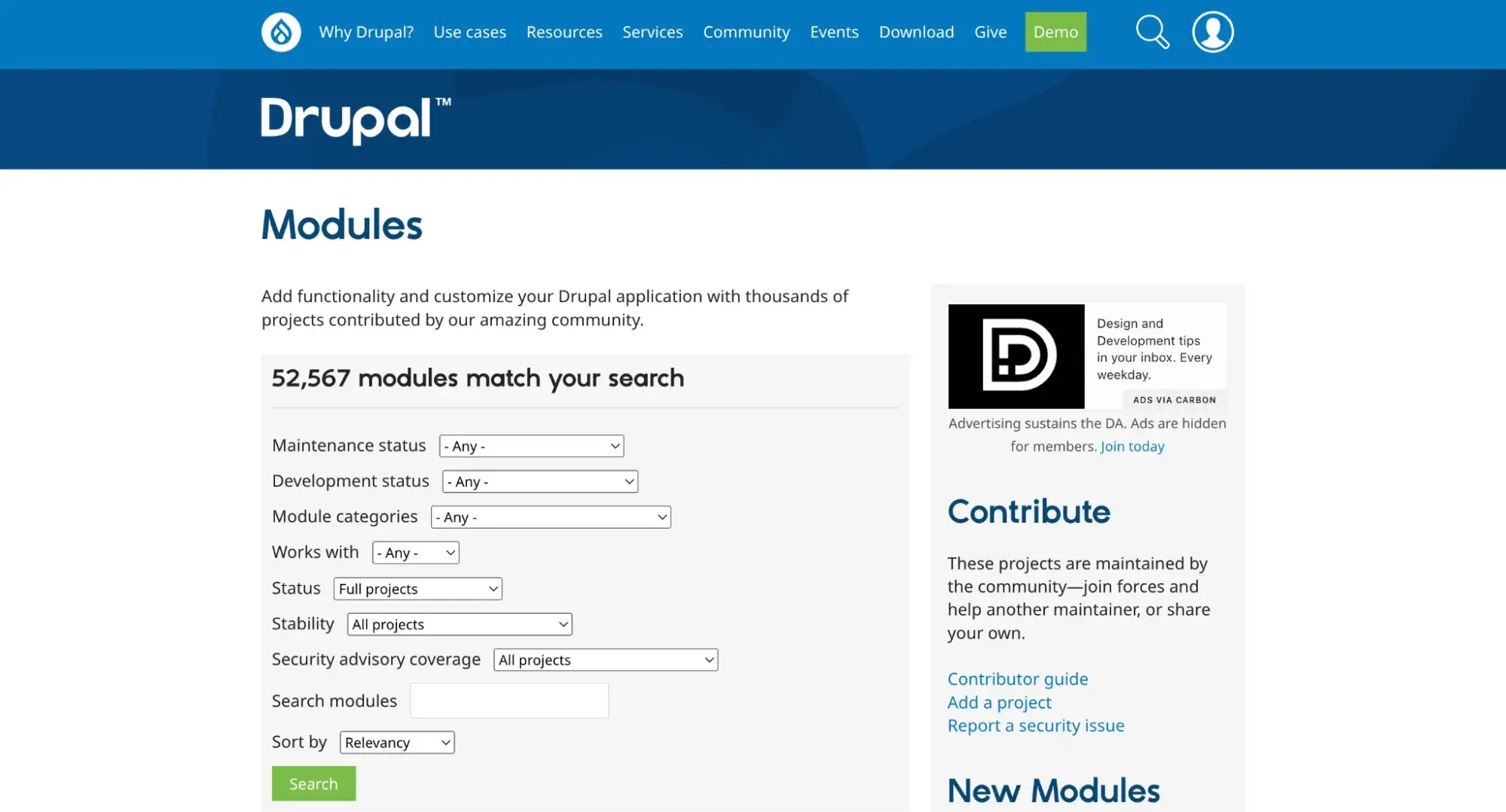
These modules enable site owners with some experience in website development to maintain granular control over their sites' functionality. For example, using modules, you can add responsive dropdown menus to your Drupal site or customize meta tags depending on the browser language.
Content Hub offers these integrations via application programming interfaces (APIs) with third-party apps, giving you access to every tool you need.
Say I wanted to improve my content strategy and SEO efforts, I’d simply integrate Google Search Console with HubSpot to bring valuable data about your website’s performance right into your CMS. No hassle.
9. Detailed Analytics
When building a content strategy, you need to know what works and what falls short. Analytics help you make these calls. I want to know where my target personas are based, what device they’re using, and which pieces of content are most popular.
Ideally, your CMS will have built-in analytics to measure these performance indicators in your dashboard. If it doesn’t, it should at least offer an integration with Google Analytics or another popular analytics tool.
With WordPress, for example, you can install a Google Analytics plugin. Those analytics are directly in your dashboard if you use HubSpot with our WordPress Plugin.
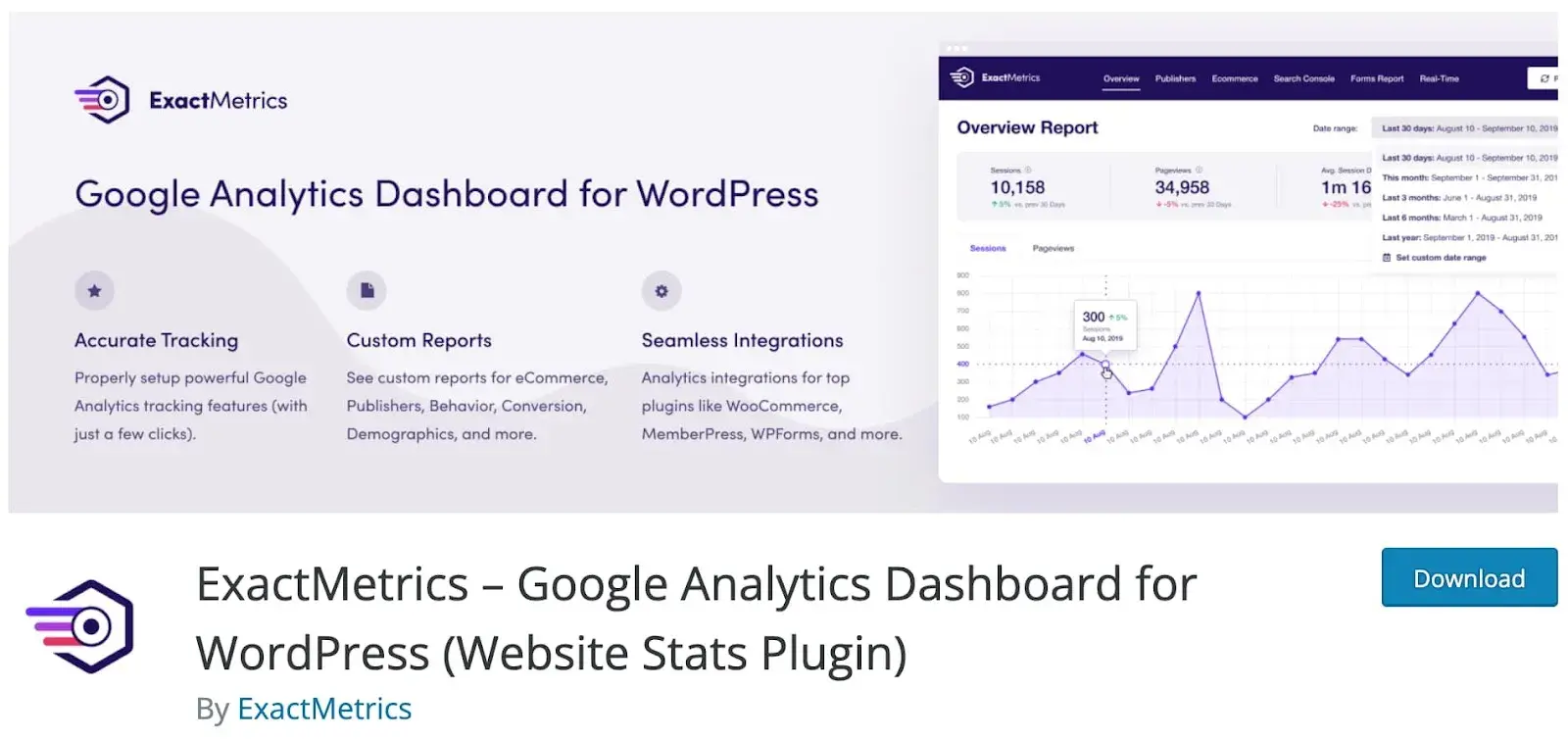
10. Pre-Made Templates
Similar to themes, pre-made templates allow you to customize your site without starting from scratch. That’s especially helpful if you have a vision but don’t know how to code. While it might sound like they do the same thing, a template differs from a theme.
A template is a single-page layout available within a theme or compatible with a theme. It is also downloadable separately. Many CMS platforms offer pre-built landing pages, website pages, and email templates to help maximize your marketing efforts.
But what if you don’t find a template that meets your specific needs? In that case, the best choice is a CMS that allows you to create custom templates and styles.
Content Hub is one example. In addition to providing over 12,000 templates in its Asset Marketplace, HubSpot allows developers to create custom JavaScript, HTML, HubL, and CSS assets in the same place where the pages are published.
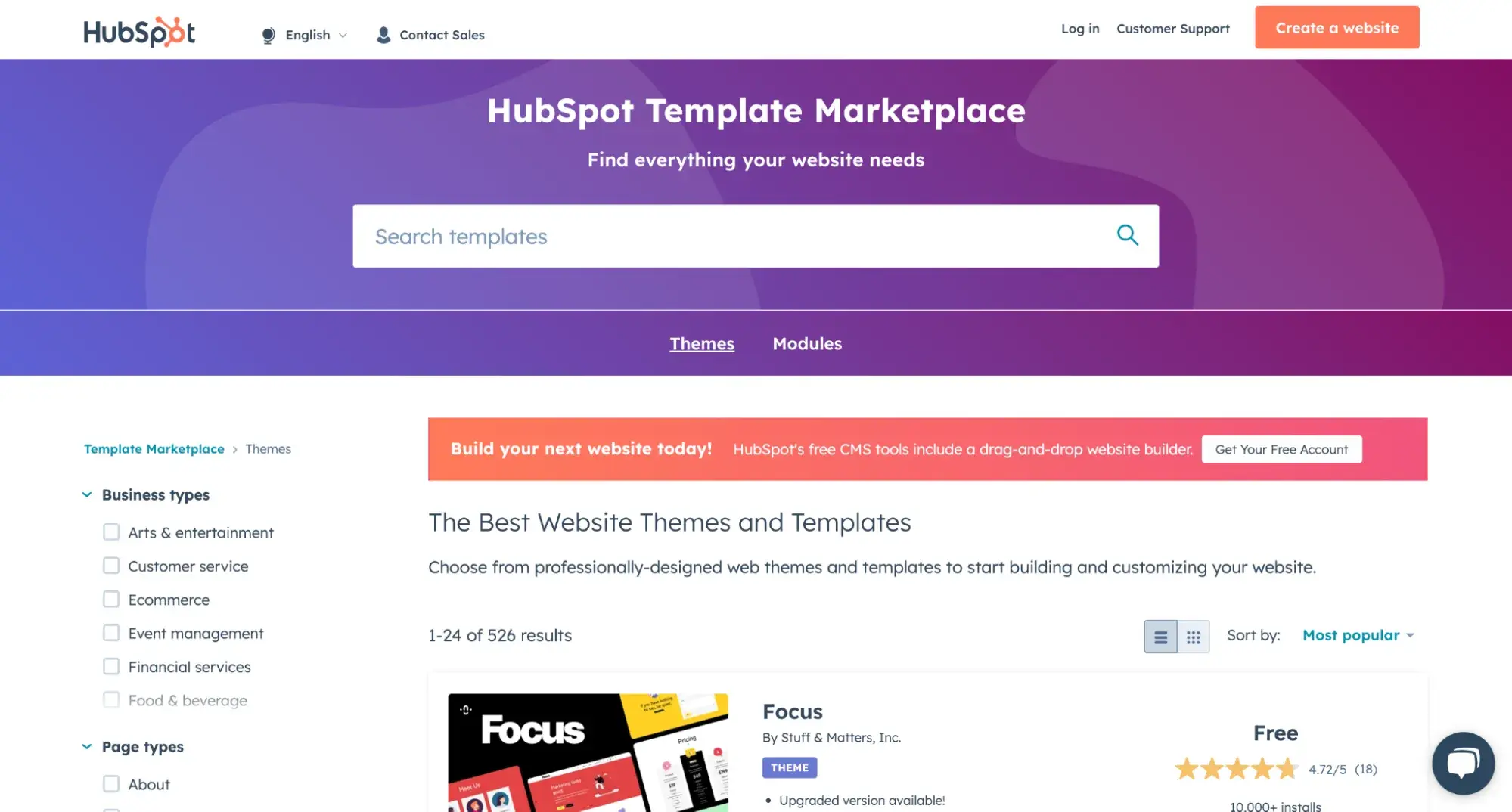
11. Content Staging
Whether you‘re launching a new product or completely overhauling your site’s design, you’ll need to make changes. Ideally, you want to see what those changes look like before you permanently add them to your design. That’s why staging sites matter.
For example, my writer website has had different looks over the years as I’ve grown in experience and the clients I work with. Whenever I made these changes, I tested them on a staging site instead of my live website. Using a staging site allowed me to confirm that everything was working well before users could see it.
While some platforms require you to sign up with a specific hosting provider or download a module, others, like the Content Hub, come with a built-in staging environment:
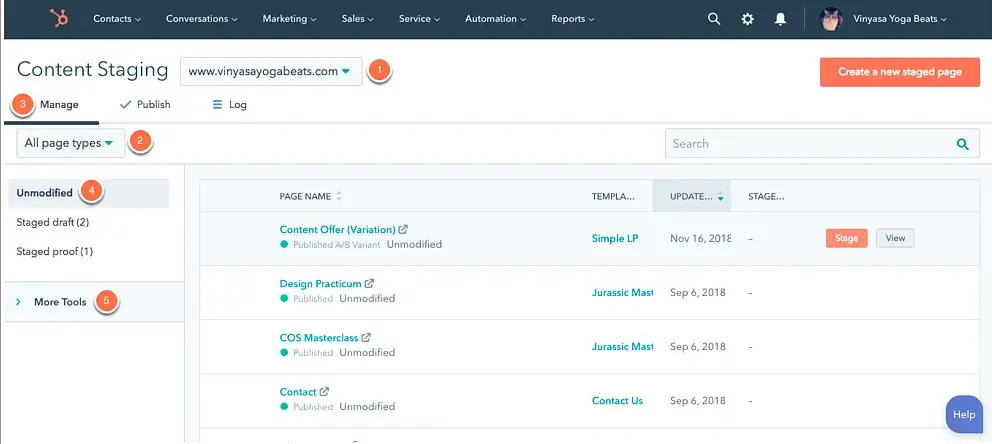
12. Security
Maximizing the security of your site protects your data, visitors, and brand reputation. The Federal Trade Commission received over 280,000 reports of identity theft in the third quarter of 2024 alone. That doesn’t even include other forms of cyberattacks.
As a website owner, especially one that asks for personal information, it’s your responsibility to protect your customers and their information. When evaluating different content management systems, consider the platform's built-in security features. From there, assess how much work it will take for your team to rach your security standards.
Here are a few questions you might ask when evaluating the security of a platform:
- Does it come with a content delivery network (CDN) to help prevent DDoS attacks?
- Is SSL included, or must you purchase an SSL certificate separately?
- Does it have a Web Application Firewall to prevent hackers from accessing your site?
- Does it have a security team? If it does, is this team comprised of community members or employees?
- How often are static code analysis and vulnerability scans run? Are these integrations that can do this for you?
- How difficult is updating the software when a security patch has been released?
13. Support
Most open-source platforms do not have customer service departments that you can call with questions. Instead, they provide extensive documentation and then rely on an engaged community of users to create and run wikis to fill in the gaps.
Joomla, for example, has 790,000 community members who regularly engage with each other in the Joomla support forum to discuss the software.
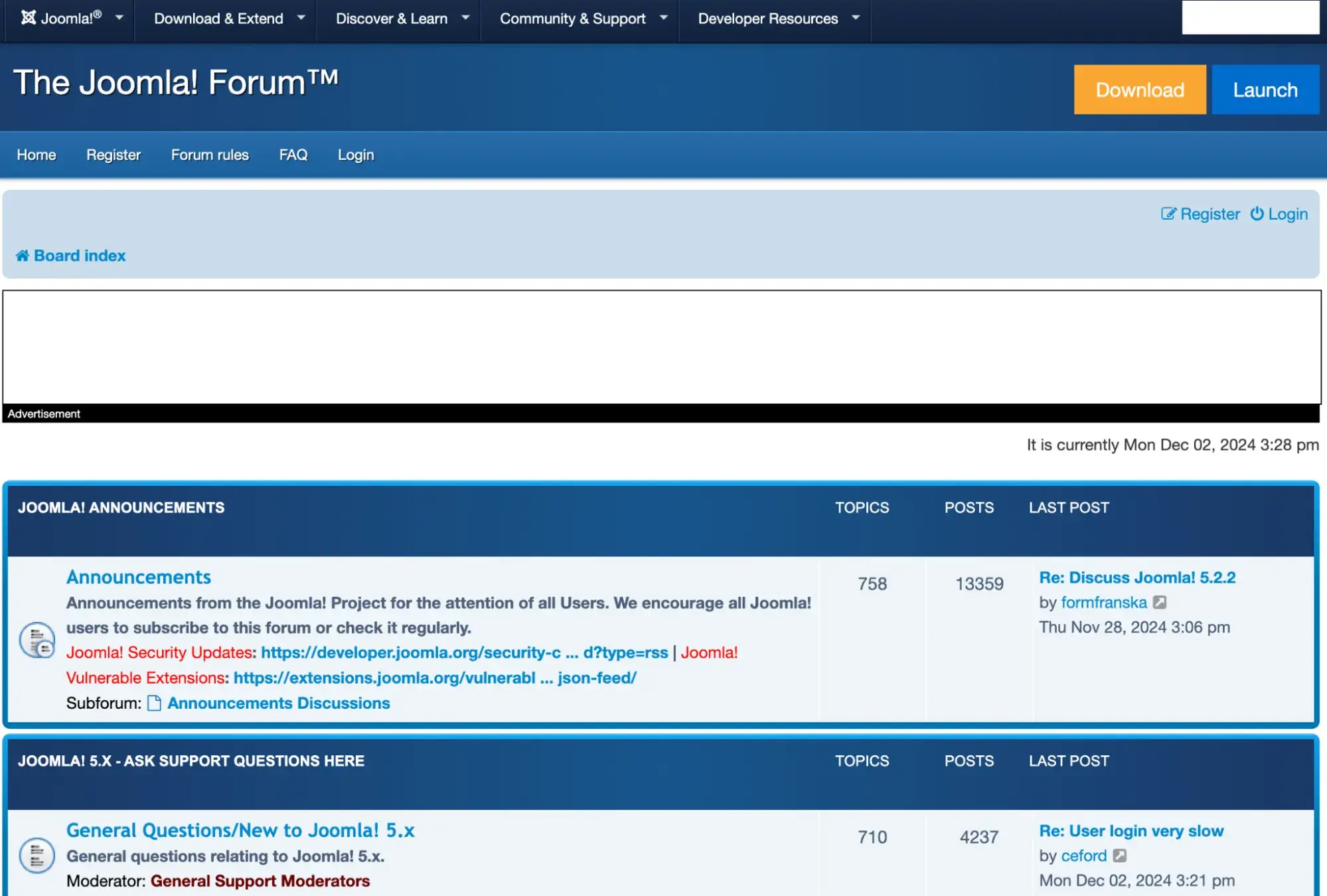
Open-source communities can be a reliable source of information that enables you to resolve issues by yourself. However, you may not always have the time to look through these resources or wait for an answer in a support forum.
Let’s say my site goes down, and I can’t figure out why. I would want help as soon as possible. In that case, a proprietary CMS that offers live support would be ideal.
When evaluating platforms based on support, consider the different types of support they offer for non-critical and critical situations.
14. Migration
While website migration doesn’t happen daily, it could tank your traffic and revenue if not handled properly. So, from the onset, it’s crucial to consider content management systems with features to help with the process. Some even offer secure migration services if you’re moving from another CMS.
Alternatively, it’s worth seeing how you might migrate your content out of the CMS. You may find the CMS isn’t the best option for your company, or you may need a more scalable solution as you grow. You’ll want to export your information easily.
In any case, check how you can safely get your data off the platform. Does the company help you, or do they block the exit?
15. AI-Powered Content Creation
Unsurprisingly, many CMS platforms already have artificial intelligence (AI) features available to users. These AI features make creating, managing, and optimizing your content faster.
For instance, I can write new or rewrite existing content on my website using HubSpot’s Breeze (which integrates natively with Content Hub). Breeze can help me identify topics that would be genuinely helpful for my audience. From there, it can also create a draft or an outline that I can follow.
Sometimes, I want to write quick web copy for a standard landing page. I love that I can rely on Breeze to get the job done fast.
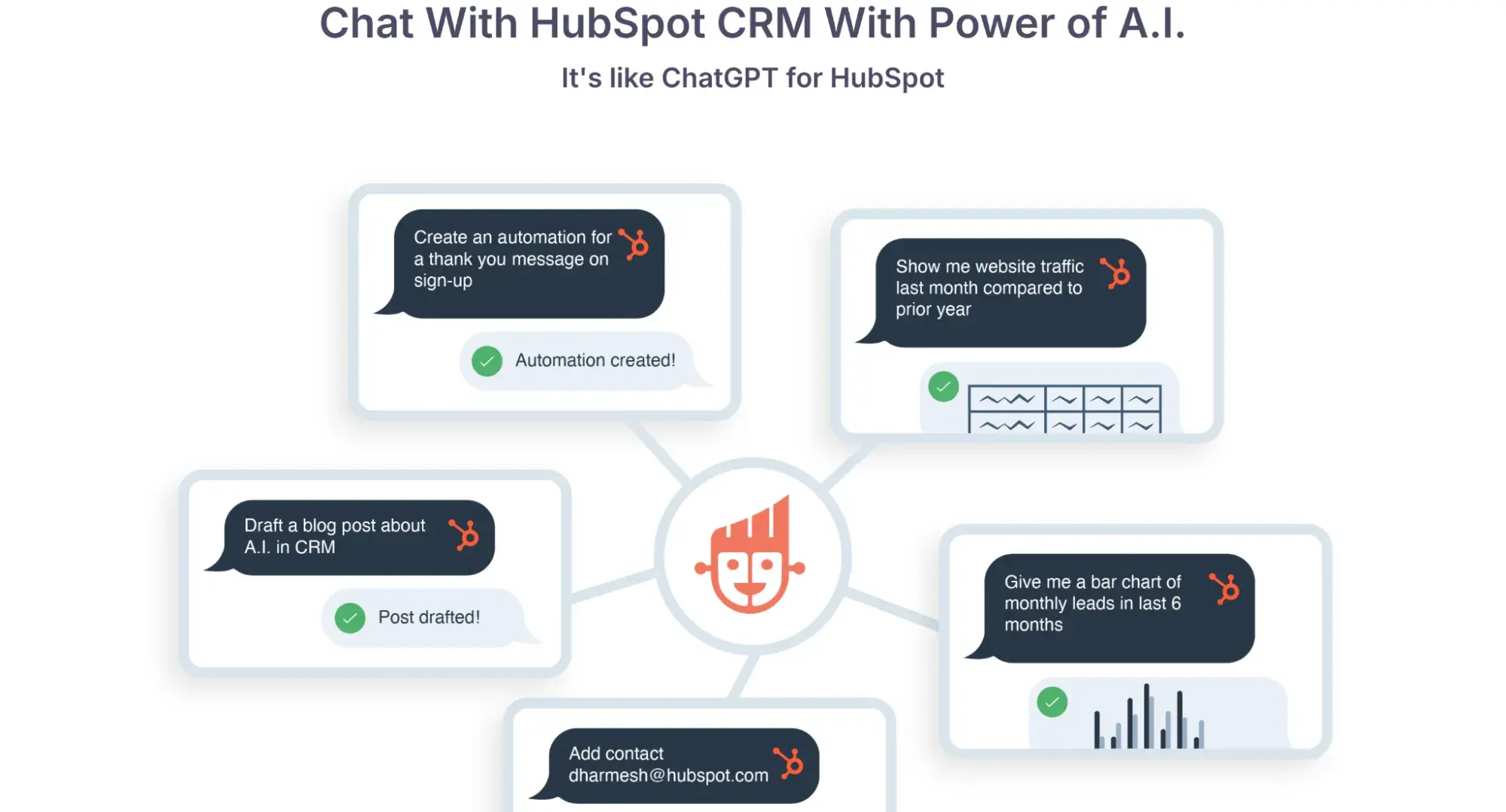
16. AI-Powered SEO Recommendations
AI can do more than just help you create content. These features can also help you get eyes on the pieces you write. That’s why I love AI-powered SEO recommendations. This feature can be found in a few CRMs, but I’ll focus on HubSpot’s CMS Hub.
Here, HubSpot’s AI can dive into your domain and look to see what SEO factors may be dragging down your ranking. The AI then gives you suggestions for changes you can make.
In the example below, you can see that HubSpot’s AI has flagged pages with duplicate content, missing meta descriptions, and duplicate tags. AI-powered AI features can help you know when to focus your SEO efforts, even if optimization isn’t your specialty.
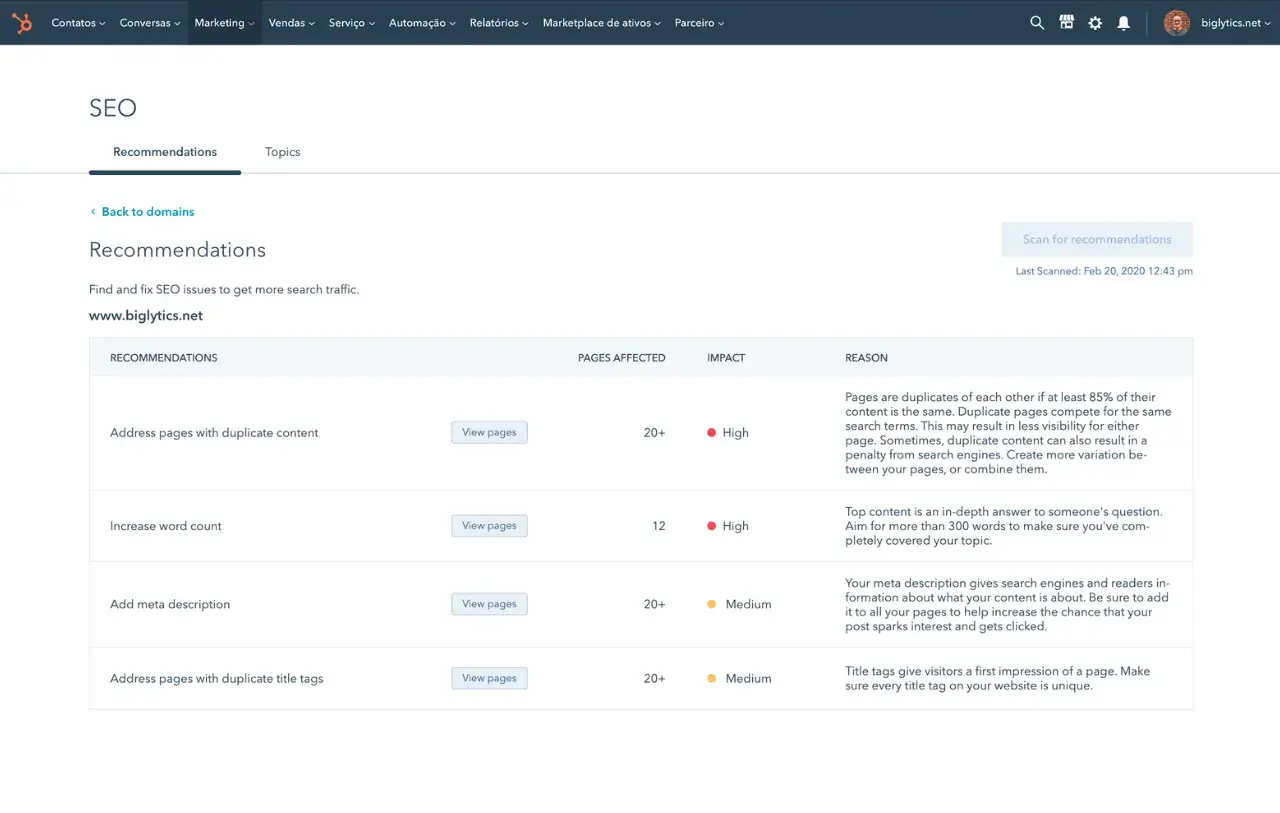
Finding a CMS that Fulfills Your Business Needs
I’ve seen content management systems in different shapes and sizes, each with unique selling points. While many of these systems have some nice-to-have features, I alway focus on the core. I can’t compromise on thse elements.
A platform that combines a user-friendly dashboard with built-in SEO tools and advanced security configurations will allow you to grow a site that delights your visitors.
A CMS that works for me might not work for you. So take the time to audit your business, determine what you need, and choose a CMS that’s right for you.
Editor's note: This post was originally published in June 2020 and has been updated for comprehensiveness.
Content Management System








![20 Best Membership Website Builders and Platforms [+My Favorite Examples]](https://53.fs1.hubspotusercontent-na1.net/hubfs/53/14%20Best%20Membership%20Website%20Builders%20and%20Platforms%20in%202022%20%5B+%20Website%20Examples%5D.png)



